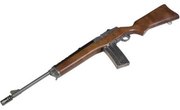
Gunsmiths in colonial times repaired guns and produced long rifles. In Europe, gun parts such as barrels, stocks, locks and fittings were jobbed out to specialists for quality and efficiency. Colonists could not compete with the speed or cost of making guns, so they focused on repair, not production. Long rifles were an exception. Colonial gunsmiths were masters of the long-barreled rifle. For repairs and manufacture, gunsmiths used hand tools that came from England.
Blacksmithing Tools
To repair or construct barrels and other metal parts, a gunsmith used blacksmithing tools. A forge is the source of heat. The forge has a hearth where metal can be heated. A nearby tank of water is used for cooling. The smithy squeezes the bellows, a leather bag, to force air out on the coals to raise the temperature of the fire. Long-handled tongs were used to hold hot metal over the forge and to shape it on the anvil. The smithy used hammers to force the metal into different shapes. Gunsmiths also used swages, metal tools used to bend and shape hot metal.
Farrier Tools
Gunsmiths who were blacksmiths also made horseshoes. Tools they used for those chores were also adapted for use in gunsmithing, such as the rasp, cat's head hammer, farrier stand and other files and hammers.
Metal Files
Long metal files with wooden handles were used to file metal while making and repairing guns. A craftsman would need a variety of files of different coarseness for work ranging from rough shaping to fine, smooth finishing.
Vise, Drills & Augers
Craftsmen used a vise to hold a gun or rifle immobile while they worked on it. They employed hand drills and augers, which turned manually by twisting the wrist. Other small implements would include tweezers, clamps, wrenches, screwdrivers and reamers for widening drilled holes.
Woodworking Tools
The grips and stocks of rifles were made of solid hardwood; gunsmiths were woodworkers too. They used saws, planes, rasps and chisels to fashion the handgun's grip or rifle's stock. Some added ornamental decoration for an extra flourish.
Rifling Tools
Colonial gunsmiths used three tools specifically engineered for rifle makers: the boring bench, the rifling bench and the pan borer. The boring bench was used to bore the newly forged barrel to the proper caliber. A hand crank propelled the borer as it cut through the length of the barrel. Similarly a rifling bench held the barrel while a spirally grooved cylinder cut the rifling grooves uniformly inside the barrel. The pan borer cut the depression required in the lock's firing pan for holding the priming charge. The instrument was a rotary file held in place so it could be turned by a drill bow.
References
Writer Bio
Nancy Kerstetter’s first professional writing experience began at the Fort Worth Star-Telegram while pursuing her journalism degree at Texas Christian University in the 1970s. She’s worked in public relations and as an editor of a youth camp trade magazine. Currently she writes for small businesses in and around Dallas. Kerstetter travels extensively on business and pleasure in the United States and internationally.



